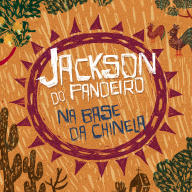The vigorous syncopation exhibited by the interplay of his singing and his inseparable pandeiro (a kind of tambourine with jingles), an inheritance of the black culture that produced the coco from Alagoas, made it quite natural for him to adapt to the Southwest music, namely the Carioca sambas and Carnival sambas. Bringing to Carioca TV and radio, as early as the mid-'50s, the lively poetry and singing of the cantadores (Northeastern minstrels) of the fairs, full of improv and humor, Jackson took by assault the audiences that crowded his live performances in the highly popular auditorium radio shows in which he participated -- like the Programa César de Alencar, on the Rádio Nacional -- producing success after success. At the same time, he was the first one to blend the Carioca malandragem (street wisdom) with swinging Northeastern cocos and emboladas (an ancient form of rhythm and poetry sung to the accompaniment of just a pandeiro).
Son of a singer devoted to the folkloric cocos of her region, Flora Mourão, Jackson (who was nicknamed "Jack" by his mother, after his physical resemblance to actor Jack Perry; adopting later, as a professional, his stage name) started in music playing the zabumba (folkloric Northeastern drum) to back up his mother. After a series of hardships beginning in childhood as a peasant and throughout his youth, when he worked as a baker and later as a drummer in the joints of João Pessoa (Paraíba), in the early 50s he was hired by the Rádio Jornal do Comércio (Recife, Pernambuco). At that station, which was being inaugurated, he adopted the stage name Zé do Pandeiro (and then Jackson do Pandeiro) and recorded his first 78 rpm single and had his first hit with the xote Sebastiana (written by Rosil Cavalcanti, with whom Jackson had a duo at the time). The song is evidence of the rhythmic/stylistic innovations based on improvisation that Jackson was devising within the core of traditional Northeastern music. Singing cocos that were mostly his mother's repertory, Jackson had local success, recording several albums that introduced him to the distant audiences of Rio de Janeiro; like the rojão Forró no Limoeiro, which brought him enough money to finance his and Almira's trip to Rio. Getting to know the amateur singer/dancer Almira Castilhos de Albuquerque, Jackson formed with her the duo Jackson do Pandeiro e Almira.
Almira had a prominent role over Jackson's life, having been the person who taught him how to write his own name. Her sensuality as a dancer and his enormous talent as a singer/percussionist/entertainer soon were acclaimed, and they departed to Rio de Janeiro in 1954. In Rio, Jackson came to know in person the Carioca journalists that were already celebrating his music on paper. The duo's first record in Rio was a collection of previously released singles in 1954 called Sua Majestade O Rei do Ritmo, gathering Northeastern rhythms like the rojão, the coco alagoano, the xote, and the batuque nordestino, along with the Carioca samba.
Returning to João Pessoa, Jackson and Almira married in October of that year, but didn't find the same warmth from their audiences. Recording the Xote de Copacabana (a tribute to Rio), the two of them returned to that city in 1955, settling there permanently. Jackson started to perform at radio stations Tupi and Mayrink Veiga, having been hired by Nacional. In São Paulo, he worked in clubs and radio stations Record, Nacional, and Bandeirantes. During the '50s, the duo was popular enough to perform in several films like #Minha Sogra é Da Polícia, #Cala a Boca Etevilna, #Tira a Mão Daí (in which Ângela Maria, Virgínia Lane, Linda Batista, and Dircinha Batista also worked), and #Batedor de Carteiras. Until the duo's dissolution in 1967 (with the end of the marriage), they were backed by the Pau de Arara trio, later renamed as Trio Borborema.
Encouraged by the reception of the market, Jackson started to record with success Carnaval marches like Mão na Toca, Intenção, Vou Gargalhar, (Edgar Ferreira, 1955), Boi da Cara Preta (Paquito/Romeu Gentil/José Gomes, 1956), O Velho Gagá (Almira Castilhos/Paulo Gracindo, 1961), and the biggest hit of the Carnaval of 1962, Me Segura Que Eu Vou Dar Um Troço (Jackson/Arnô Provenzano/Otolindo Lopes).
Jackson had a broader success from the mid-'50s until the late '60s, during the period in which he kept the duo with his wife Almira. With the "Jovem Guarda" and the explosion of youth music in the '60s, the opportunities for Jackson gradually diminished and the duo came to an end, together with the marriage, in 1967. It was only in 1972 that Jackson's contribution to Brazilian popular music would be celebrated, by Gilberto Gil's re-recording of Chiclete com Banana (not by coincidence, a song whose lyrics are full of references dear to Tropicalia) on Gil's Expresso 2222. The title track also evidences Jackson's strong influences in the vocal/rhythmic line. Gil later re-recorded O Canto da Ema and A Cantiga do Sapo, while Gal Costa re-recorded Sebastiana. Also in 1972, Alceu Valença called Jackson to perform as a duo Valença's Papagaio do Futuro. It was enough to reinvigorate the coco master, who returned to the recording studios and tours throughout Brazil, nevertheless restricted to the June parties known as festas juninas, with its specific repertory of marchas juninas.
After another decade of activities and lesser popularity, Jackson died on the road, soon after doing a show. One year after his death, he was paid tribute in São Paulo in the 30 Anos de Rojão performance, with the presence of Zé Kéti, Odair Cabeça de Poeta, Paulinho Boca de Cantor, Edgar Ferreira, and others. In 1997, Jackson was given an homage during the ceremony of the Sharp Awards. ~ Alvaro Neder, Rovi












